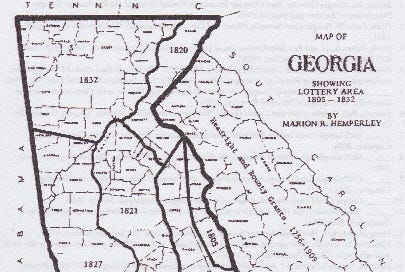Have you considered researching all of Georgia’s Land Lotteries, viz: 1805, 1807, 1821, 1822, 1827, 1832.
Those entitled to one draw in the lottery had to be a bachelor, 18 years or over with a three-year residency in Georgia, citizen of the United States or a Soldier of the Indian War and resident of Georgia since military service. Others who could drew were: married man with wife or son under 18 years or unmarried daughter or widow with three years residence in Georgia; wife and/or child; husband and/or father absent from state for 3 years; family (one or two) of orphans under 18 years whose father was dead and three year residence. Those entitled to 2 drews were a family (three or more) of orphans under 18 years with three years residence; Widow, husband killed in Revolutionary War, War of 1812, or Indian War; Orphan, father killed in Revolutionary War, War of 1812 or Indian War; Wounded or disabled veteran of War of 1812 or Indian War, unable to work; Veteran of Revolutionary War. Veterans of the Revolutionary War who had been a fortunate drawer in any previous Lottery could have one drew. The grant fee was $18.00 per land lot. The tax digests reflect land given in this lottery and contains information as to his boundaries, i.e., waterways, timber land, etc. Although many people drew, everyone did not always take up the land. The way to discern purchased land from land from the lottery is that those lots consisted of 202-1/2 acres.
Thus, the researcher should also search the deed records in conjunction with lottery draws and the (above) map. As counties were established and changes of border lines were divided counties, the lottery was the vehicle of settlement. One should always consider the parent county. That is to say, search all the records in the surrounding counties.
More . . . 1820 Land Lottery; The Path into Georgia during the Land Lotteries; The Georgia Land Lottery



